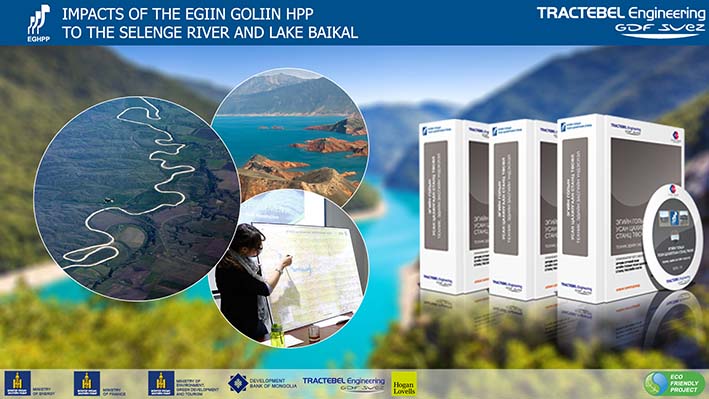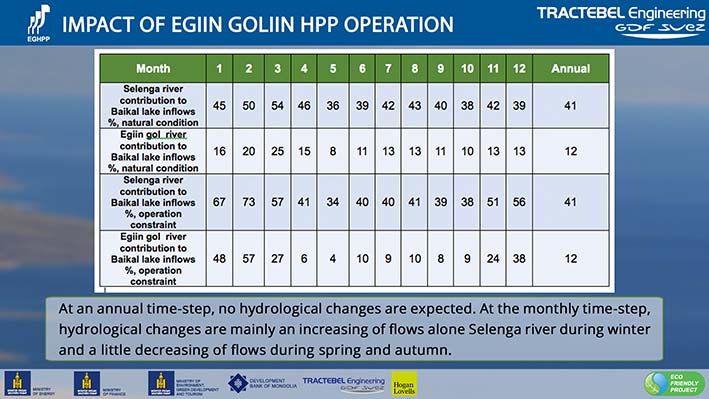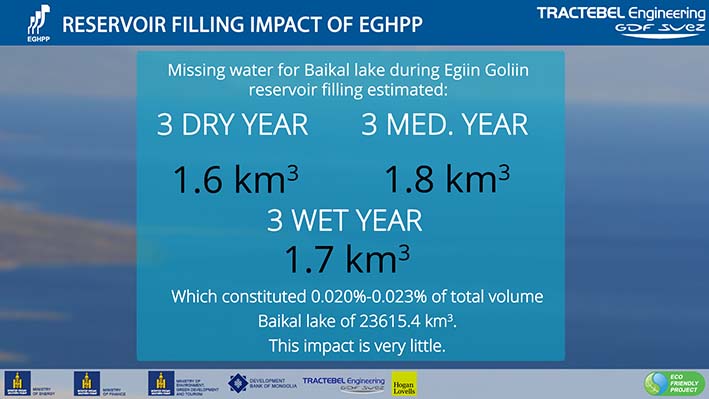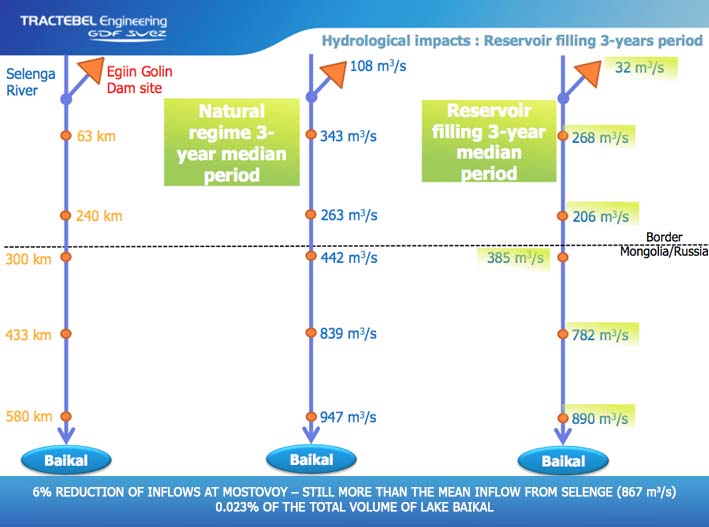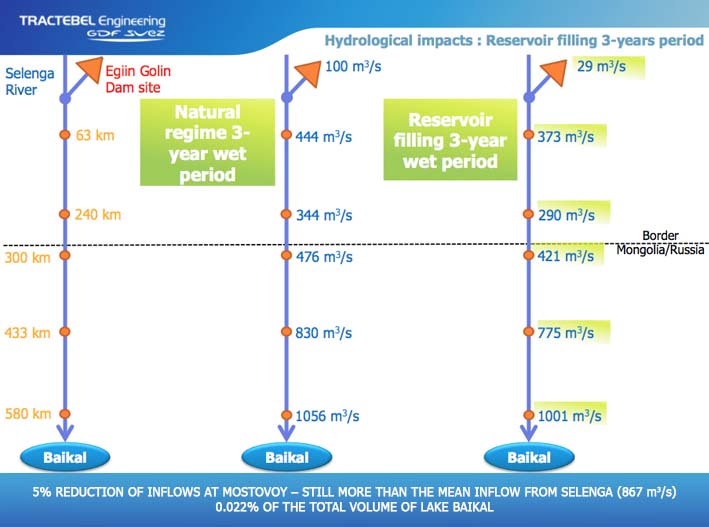- The operation of the EGHPP will contribute to the central energy system of Mongolia hence it will be independent from foreign countries.
- Egiin Goliin Hydro power plant will be the 1st high capacity hydro power plant in Mongolia.
- In 2015, total demand of electricity will exceed over supply.
- Egiin Goliin hydro power plant is one of the highly possible variation which can replace import of electricity.
- Central energy system of Mongolia imports annually $ 25 mln of electricity.
- Egiin Goliin hydro power plant will guarantee the national security of electricity.
- According to the geological study, the EGHPP geological condition of the dam foundation is found to be very agreeable.
- In November 2013, the Government of Mongolia passed resolution to start the construction of Egiin Goliin hydro power plant.
- Over the years total cost of the building power plant is increasing.
- The EGHPP is located at the confluence of Egiin and Selenge river 2.5km upstream.
- Construction of EGHPP will open opportunities of farming the water birds, fish and sable breeding.
- To fill the reservoir with water during summer and to generate electricity during winter.
- In the area of Egiin Goliin hydro power plant, annual precipitation is between 300 and 310 mm.
- In the area of Egiin Goliin hydro power plant, average temperature in December is -40 C, in July and August are +25 C.
- An ice phenomena of EGHPP, will be at its highest in December will reach 1.5m.
- In the area of Egiin Goliin hydro power plant, mean wind speed is 2.3 m/sec, humidity level is 72%.
- Since 1977, Mongolia paid $311 mln which equals to 451 bln of tugrugs on electricity imported from Russian Federation.
- Start up minutes of hydro power plant is 2-5 minutes in contrast to Thermal power plant 2-4 hours.
- Central energy system’s daily load during the winter is 776-800 MW.
- The EGHPP generated energy will be connected to the CES via 2 circuits double conductors with capacity of 220 kV.
- The main criteria for meeting the environmental objective are avoided of carbon dioxide (CO2) emissions, and the specific carbon offset of the project is determined in terms of carbon dioxide (CO2) emissions avoided per GWh over the lifetime of the project and thus EGHPP reduces 709 thousand ton of CO2 annually.
- By 2022,EGHPP is to produce 581 million kWh annually at minimum and the annual electricity generation is to vary between 581 to 2662 million kWh.
- By the April 2014 investigative study discovered 218 artifacts at the hydropower plant DAM SITE (910м), and 24 artifacts at the infrastructure route.
- 242 artifacts are planned to be excavated and preserved in 2014-2015.
- 423 species of plants grow at the Egiin Goliin DAM SITE.
- Hydropower costs less than most energy sources.
- Renewable Energy creates three-times more jobs than fossil fuels.
- In 1878 the world's first hydroelectric power scheme was developed at Cragside in Northumberland, England by William George Armstrong.
- Hydropower today provides about 20 % of the world's electricity and is the main energy source for more than 30 countries.
- Hydropower facilities can quickly go from zero power to maximum output, making them ideal for meeting sudden changes in demand for electricity.
- Hydropower can also be used for water supply, flood control, irrigation and even recreation purposes.
- The financial status of the hydroelectric industry is generally healthy due to long equipment life and low maintenance and operating costs.
- Egiin Goliin hydropower plant is estimated to cover the investment in 20-25 years of time with its sales income.
- Thermal power plants in UB city burns 3.5 million tons of raw coal, pollutes the air with 4 tons of coal, 4.5 million cubic meters of gas and 6kg emissions of sulfur gas.
- The Eg river is Mongolia's third largest river, and at the proposed dam site has a catchment area of about 40,000 km².
- Due to Mongolian country characteristics and situation, the value of 315 MW installed capacity has been selected.
- There are 21 types of fish at the Eg river.
- The new bridge that will be built across River Selenge will be a steel concrete bridge.
- Turbines and generators are expected to be replaced after 32 years of operation.
- Peak demand of the Mongolian energy system reached 948 MW, exceeding both installed and feasible generation capacity and the reason for increased imports of electricity
- Electricity is imported from Russia to the Central Region Integrated System via Selendum sub-station Russia and Darkhan sub-station Mongolia.
-
CONTRACTOR -
 TRACTEBEL ENGINEERING (GDF SUEZ) S.P.A
TRACTEBEL ENGINEERING (GDF SUEZ) S.P.ATractebel Engineering (GDF Suez) of France is working as a consulting company of the Egiin Goliin HPP. Tractebel Engineering is a business unit of GDF SUEZ Energy Services, the European leader in multi-technical energy related services and one of the key business lines of GDF SUEZ. Headquartered in Brussels (Belgium), and with offices in 33 countries and projects in over 140, Tractebel Engineering undeniably is a top-level partner for every single of its clients. Tractebel Engineering is a global engineering consultancy company with more than 100 years of expertise in energy and infrastructure projects. Tractebel Engineering employs around 4,400 people. Tractebel Engineering has undertaken around 650 dam engineering projects in over 70 countries worldwide. Of those studied, 250 dams have been built to date.
-
SUBCONTRACTOR -
 MONGOLIAN NATIONAL METEOROLOGY AND ENVIRONMENTAL MONITORING
MONGOLIAN NATIONAL METEOROLOGY AND ENVIRONMENTAL MONITORINGMeteorology and Environmental Monitoring is the Government Implementation Agency to store and protect information and documents of meteorology and environmental monitoring, and provide archival customer services. The Egiin Goliin hydropower plant project unit has been cooperating with this organization for collection, processing and analyzing meteorological and hydrological data of the Eg river basin, Khutag-Undur soum of the Bulgan province where the project is planned to be implemented.
-
Date: 2014.12.09 - 2014.03.15 -
BASIS -

It was required to make a study of impacts to be caused by the Egiin Goliin HPP proposed to the Selenge river natural flow regime and inflow to Lake Baikal within the framework of this updated Feasibility Study by Tractebel Engineering (GDF Suez), France.
-
IMPORTANCE -

In the study of hydrological impacts to the Selenge River and Lake Baikal Tractebel Engineering (GDF Suez), France considered hydrological regime during operation of Egiin Goliin HPP and the time period required to fill the reservoir taking into account of 3 successive years with low, medium and high water in dependence on climatic conditions was of a great importance. Thus, the scales of impacts caused during operation of the Egiin Goliin HPP and during reservoir filling period were accordingly estimated.
-
CONCLUSION -

To comprehend the impacts on ecology caused by hydrological changes taken place by operation of the HPP the impact of grade-level method was used. For evaluation of back water effect at the downstream of the dam we have used water-ecological method which was of great importance for a comprehensive assessment of socio-ecological impacts. The results of the study made by water-ecological method served as a basic data for evaluation of changes in the aquatic life which is an essential component of socio-ecological impact assessment. The final conclusion was that the operation of Egiin Goliin HPP will not cause any impacts on the annual inflow of the Lake Baikal. There will be only minor changes in monthly inflow for instance: winter inflow increases a little bit and inflows in spring and autumn decreases a little bit. During reservoir filling period water deficit to be caused to the Lake Baikal is estimated to be to the extent of 1.6-1.8 km3. If we compare this figure to the whole (23,615.4 km3) volume of the Lake Baikal it would be only 0.020%-0.023%, or from this we can conclude that the impact can be caused to the annual inflow of the Lake Baikal is insignificant.
DAM SITE
-
THE DAM SITE IS LOCATED
2.5 KM FROM THE CONFLUENCE OF THE EG-SELENGE river in KHUTAG-UNDUR SOUM, BULGAN PROVINCE.
RESERVOIR
-
NORMAL WATER LEVEL
910 M A.S.L -
VOLUME AT NORMAL WATER LEVEL
5.7 BILLION m3 -
SURFACE AREA
154.3 KM2
DAM
-
DAM CREST LEVEL
912 M A.S.L -
DAM CREST WIDTH
8 м -
DAM CREST LENGTH
740 M -
DAM HEIGHT ABOVE NATURAL GROUND
82 м -
DAM VOLUME
2.29 MILLION m3
POWER HOUSE
-
INSTALLED CAPACITY
315 МW -
ANNUAL ELECTRICITY PRODUCTION
606 MILLION KWh -
TURBINE
FRANCIS 4 X 68.78 MW, 2 X 20.5 MW, 1 X 3 MW
PROJECT INFRASTRUCTURE
-
FROM THE DAM SITE TO THE ERDENET SUBSTATION
72.3 KM DOUBLE CIRCUIT 220KV TRANSMISSION LINE -
FROM THE DAM SITE TO THE ERDENET CITY
71.9 KM ACCESS ROAD, 320 M LONG REINFORCED CONCRETE BRIDGE OVER THE SELENGE RIVER

